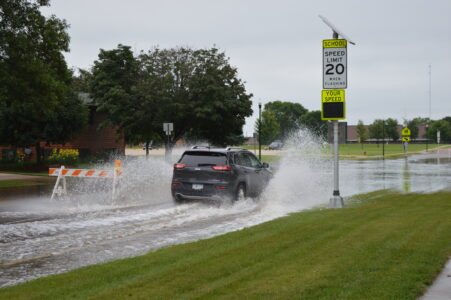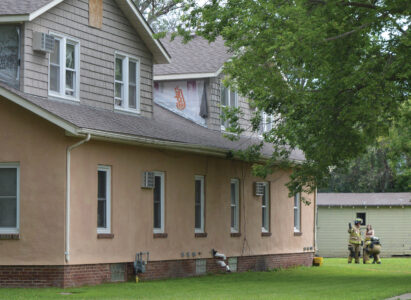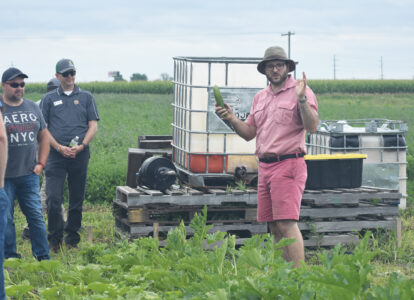Conference focuses on building connections for a better Minnesota

Photo by Deb Gau Minnesota state demographer Susan Brower spoke with delegates from across Minnesota at the “Thriving By Design” conference this week in Granite Falls and the Upper Sioux Community.
UPPER SIOUX COMMUNITY — Before he got into the results of a 2017 survey of Minnesotans, Craig Helmstetter asked his audience to make a response of their own. Did they feel more hopeful or fearful for Minnesota’s future?
Several people in the conference room stood up to answer “fearful.” But they were outnumbered by “hopeful” responses.
Helmstetter said that lined up with the actual survey responses — 82 percent of the Minnesotans surveyed said they were hopeful for the future. Other responses showed Minnesotans from different parts of the state were more alike than we might think. For example, he said, rural and urban residents were equally likely to attend religious services, or to have a permit to carry a concealed weapon.
Finding the ways Minnesotans are interconnected was a key focus at a statewide gathering held this week in Granite Falls and the Upper Sioux Community. Speakers at the “Thriving By Design” conference said the state needs both its urban and rural communities in order to prosper.
“We cannot have a zero-sum game in Minnesota,” said Dr. Bruce Corrie, director of economic planning and development for the city of St. Paul. “If we want to do this, it has to be shared.”
The three-day conference started Wednesday at the Prairie’s Edge Convention Center. Conference delegates came from across the state to work on designing a plan for equity and shared prosperity in Minnesota. Organizers said the plan, called the One Minnesota Equity Blueprint, would be inclusive of Minnesota’s diverse populations, and bring rural and urban areas together.
Brett Buckner, managing director of OneMN.org, encouraged delegates to keep talking to their neighbors throughout the conference.
“We’re all interconnected in this,” Buckner said.
The focus of several conference talks Thursday morning was on Minnesota demographics, and what the state needs to move forward.
“I want to give you the big picture of Minnesota,” said State Demographer Susan Brower. “We’re in the middle of some really big changes.”
As a whole, Minnesota’s demographics show a lot of positive things, Brower said. Minnesota has a large proportion of working-age adults who are employed, relatively low rates of poverty and a population who are highly engaged in voting and volunteering. But Minnesota is seeing some changes in how its population is growing. Since 2010, 88 percent of the state’s population growth has been in the seven-county Twin Cities metro area.
“This is pretty new for us,” Brower said. Areas around cities like Rochester, St. Cloud and Moorhead also saw population growth, she said.
“Aging is the big trend we are experiencing,” Brower said. More and more Minnesotans will be 65 or older in coming years. By 2020, she said, there will be more older Minnesotans than there will be school-age children. “It’s significant, because it’s the first time in our history that’s the case.”
The change in demographics will affect Minnesota’s workforce, as well as increasing the need for health care and services. At the same time, Brower said, the working-age population isn’t expected to grow in the next 15 years.
Brower said Minnesota has a tendency to lose its younger population, as they move away to other states. But in recent years, Minnesota has gained more young people than it has lost, because of immigration. Brower said Minnesota is becoming more diverse, and people of color make up a lot of population growth. Of Minnesota’s population of 5.5 million, one million are people of color, she said.
At the same time, Brower said, people of color face economic disparities in Minnesota.
“We see really big differences in terms of median income,” she said.
Helmstetter, managing partner of the American Public Media Research Lab, highlighted some of the similarities and divisions among people in different parts of Minnesota. The 2017 Ground Level survey was the “most comprehensive study ever done by MPR,” and was the subject of news reports on Minnesota Public Radio, he said.
The survey found that most Minnesotans surveyed thought the state was on the right track on issues like protecting clean water, education, health care, and providing equal opportunities. But there were some divisions among demographic groups and areas of the state. People from Minneapolis and St. Paul had less trust of law enforcement than respondents from other parts of Minnesota, and black Minnesotans trusted law enforcement less than white Minnesotans did.
Minnesotans were also divided on immigration. Halmstetter said the differences showed between geographic areas, with Twin Cities residents saying the state was on the right track on the issue, and residents from central Minnesota and St. Cloud saying the state was on the wrong track.
Connections between different parts of Minnesota is something that extends to our economics as well, said Kate Searls, research director at Growth and Justice.
“What I really want to talk about today is interdependencies,” between rural and urban Minnesota, Searls said. Searls conducted a pilot study to estimate the impact rural industries have on Minnesota’s urban areas.
Searls said 47 percent of Minnesota’s manufacturing sector is in rural Minnesota, and rural manufacturing has an effect that reaches into urban areas. For example, rural manufacturers may have suppliers in urban areas, or other business-to-business sales.
If rural Minnesota manufacturers experienced a growth of $1 billion in output, it would result in an additional $538 million in revenue and 3,600 new jobs statewide, she said. That figure would include jobs and revenues in both urban and rural areas.
Searls said a loss in rural manufacturing also hurts urban areas. A $1 billion decrease in rural Minnesota manufacturing would result in the loss of 1,043 jobs and around $208 million in revenue in the Twin Cities, she said.
The interdependency of Minnesota’s rural and urban areas is “real, measurable and significant,” Searls said.
The “Thriving By Design” conference continues today, with sessions focused more on designing the One Minnesota Equity Blueprint.



